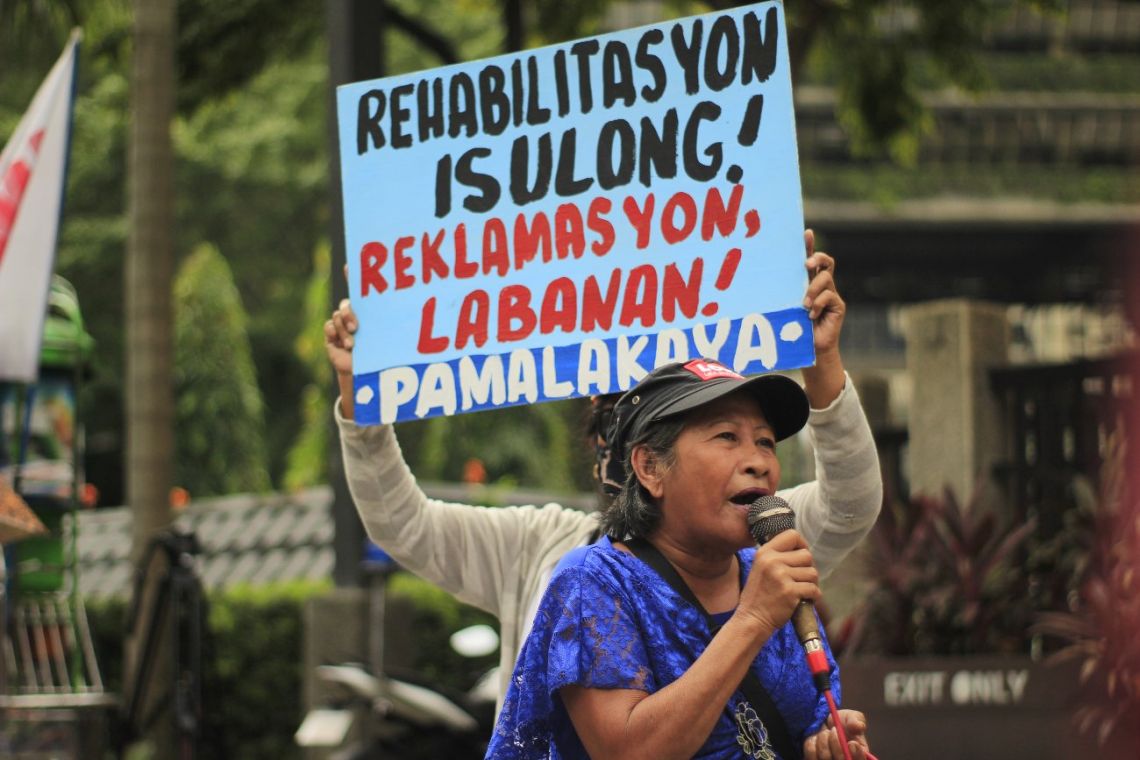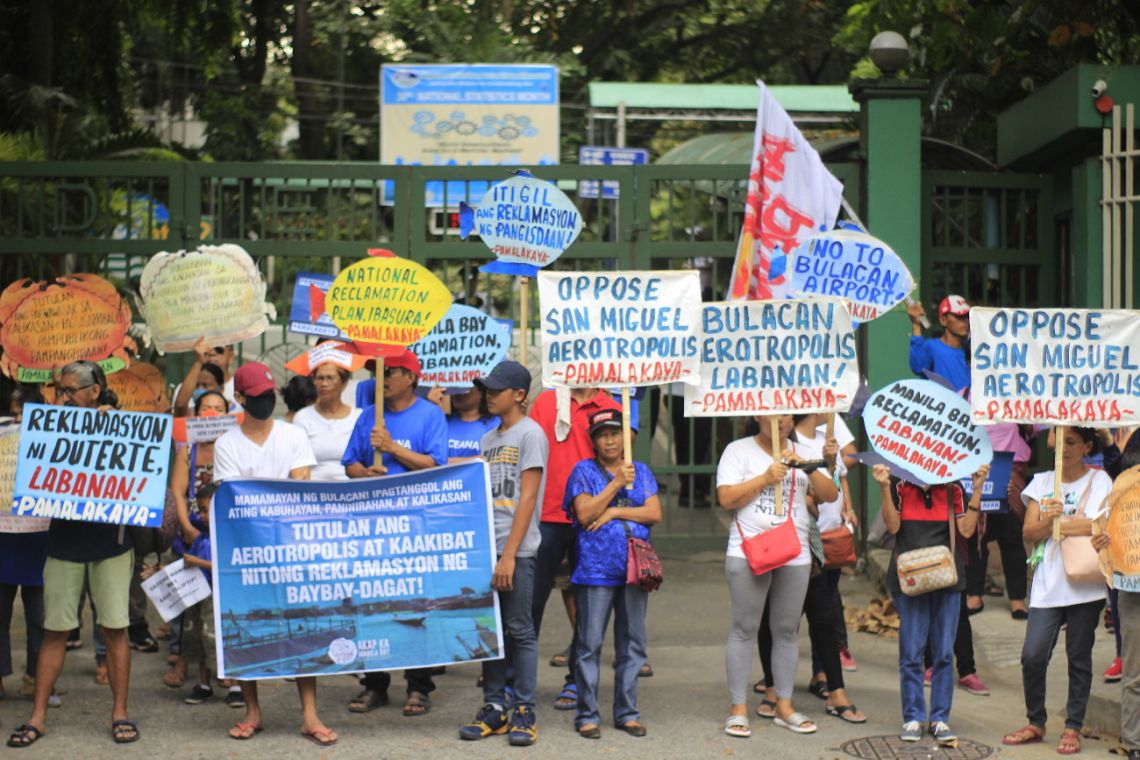Construction of the P736-billion international airport in Bulacan province will worsen flooding and accelerate the sinking of surrounding towns, a geologist warned on Saturday, June 27.
Narod Eco, member of AGHAM- Advocates of Science and Technology for the People (AGHAM) and People’s Network for the Integrity of Coastal Habitats and Ecosystems (People’s NICHE), discussed in a webinar the geological hazards of land reclamation, particularly involving the San Miguel Corp. (SMC)’s New Manila International Airport (NMIA) some 35 kilometers north of Manila.
He cited rapid coastal land sinking, increased flooding and susceptibility to liquefaction and ground-shaking during earthquakes among the adverse ecological impacts of land reclamation that would be done for the Bulacan airport project.
Eco’s warning jibes with the results of a 2014 geo-hazard study on reclamations in Manila Bay by noted Filipino-American geologist Kelvin Rodolfo, professor emeritus at the University of Illinois in Chicago. “Continuing rapid and accelerating subsidence of the coastal lands bordering the bay is worsening both floods and high-tide invasions.”

Samahan ng mga mangingisda ng Bulakan, Bulacan representative Evangeline Ilod denounces the possible loss of their livelihood and their displacement with the construction of SMC’s New Manila International Airport .
In the webinar organized by Center for Environmental Concerns (CEC) Philippines, Eco said that reclamation projects worsen land subsidence in Manila Bay.
Land subsidence is the sinking of the land surface and may occur “when large amounts of groundwater have been withdrawn from certain types of rocks, such as fine-grained sediments,” according to the U.S Geological Survey.
Preparatory work on the airport project has started on a 2,500-hectare coastal property in the boundary of Bulakan and Obando towns of Bulacan province. It is part of an envisioned 12,000-hectare township that features a residential zone, government center, seaport and an industrial zone. It will have four runways, eight taxiways, and three passenger terminals and provisions for future expansion to six runways and accommodate 200 million passengers per year. It will be three times larger than the Ninoy Aquino International Airport (NAIA) in Paranaque City.
The Department of Transportation (DOTr) awarded the project last September to San Miguel Corporation, through its unit, San Miguel Aerocity Inc. After 50 years from completion date, the airport will be fully owned by the Philippine government under a build-operate-transfer program. Disagreements over “wording and interpretation” in the concession agreement between the DOTr and SMC has delayed groundbreaking for the project, which was initially set in December 2019.
The project, which will be fully funded by the SMC, includes the construction of an 8.4-kilometer toll road that will link the gateway to the North Luzon Expressway.
Coastal towns in Bulacan, including parts of Bulakan and Obando, have been flooded during rainy days and high tide.
In 2003, Rodolfo documented that Metro Manila’s coastal areas are sinking as fast as 9 centimeters a year. He warned that if Philippine government agencies will continue development projects such as land reclamation, at the expense of enhancing the risks of land subsidence, flooding will get worse.
Meanwhile, Eco said Manila Bay’s seafloor shape worsens the risk of storm surges and storm waves. Liquefaction caused by earthquakes is more likely to happen if the Bulacan airport project is continued, he added.
“Reclaimed coastal areas are very susceptible to liquefaction and enhanced ground-shaking during earthquakes,” Eco said.
The reclamation project and these geological hazards will not only endanger the airport goers, but will displace other living organisms as well.
Concurrently, endangered and migratory birds can be a “rallying point” to conserve and protect Manila Bay, according to Cristina Cinco, vice president of the Wild Bird Club of the Philippines. She said that northern Manila Bay was declared an important bird and biodiversity hotspot.
Cinco and her team recorded that thousands of birds, varying from endemic to migratory birds, are using the East Asian Australasian Flyway found in Manila Bay. Specifically, 27 percent of the 50 million migratory birds are passing through this flyway to eat during the mid-winter season.
Among the endangered water birds with international importance are the Far Eastern Curlew (Numenius madagascariensis), Chinese Egret (Egretta eulophotes) and Great Knot (Calidris tenuirostris). The near-threatened water birds with international importance are Asian Dowitcher (Limnodromus semipalmatus), Red Necked Stint (Calidris ruficollis), Bar Tailed Godwit (Limosa lapponica), and Curlew Sandpiper (Calidris ferruginea).
Cinco added that birds are good indicators of a good environment. “What is good for the birds is good for the people,” she said.
While the conservation of the environment and the Manila Bay is important for these birds, the coastal waters of Bulacan also serve as livelihood for fisherfolks of Bulakan and Obando towns.
The airport project will cover sitios of Barangay Taliptip in Bulakan up to Sitio Baluarte in Obando.

Picket rally of fishermen from Taliptip, Bulakan, Bulacan against SMC’s airport in front of Department of Environment and Natural Resources (DENR)’s main office in Quezon City.
Residents fear displacement when the airport project begins construction. Some residents have started to demolish their houses after getting paid P250, 000 each by SMC, according to Shirley Masurca, resident of Taliptip, Bulakan.
Other residents refuse to leave because their livelihood will be affected. Without proper relocation plans, resident and fisherwoman Maria Fe Anastacio said she will stay.
“Kailangan namin ng pangkabuhayan, lokasyon, at kung kami man ay ililipat sa ibang lugar, (dapat) may pabahay, hanapbuhay, malapit sa school, at ospital para ‘di na kami mamroblema,” Anastacio said.
For Anastacio, leaving the area is not among her options and that protecting the coast of Bulacan from SMC’s project is an advocacy worth fighting for.
“Kung maaari lang di kami aalis sa lugar na ito at ipaglalaban namin ito,” Anastacio said.